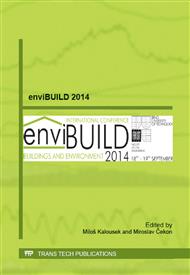p.239
p.243
p.247
p.253
p.257
p.261
p.265
p.269
p.273
Research of the Temperature Field Process in the Soil for a Home - Founded on a Foam Glass Granulate
Abstract:
Foam glass granulate is environmentally friendly, heat-insulating building material which is made from recycled glass waste. It is a very porous material with low density, with good thermal insulation properties, high static load capacity and almost zero water absorption. The paper deals with the research of the temperature field process in the soil under the floor of a passive house built on a reinforced concrete slab foundation with a layer of compacted subsoil using raw materials friendly to the environment in the form of granules of foamed glass. This method of progressive foundation of the building addresses the elimination of thermal bridges at the base and establish a continuous thermal insulating of the building envelope without thermal bridges.
Info:
Periodical:
Pages:
257-260
Citation:
Online since:
October 2014
Authors:
Price:
Сopyright:
© 2014 Trans Tech Publications Ltd. All Rights Reserved
Share:
Citation:


